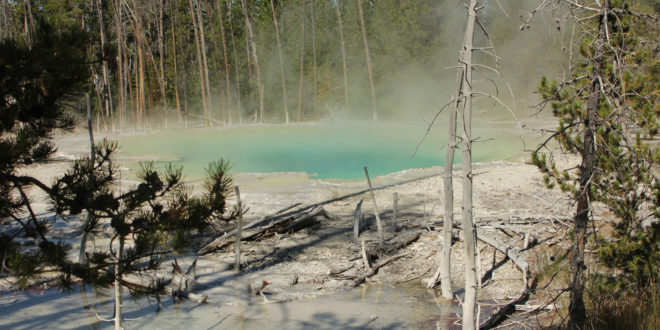The Oak Ridge National Laboratory has announced new discoveries regarding select microbes in Yellowstone’s thermal features.
According to a press release via Eureka Alert, a team at the facility (based in Oak Ridge, Tennessee and run by the Department of Energy) has isolated the archaeon (or archaebacteria, or microbe) Nanopusillus acidilobi and studied its interactions with another microbe. The team, led by Mircea Podar, has published their findings in Nature Communications.
Researchers drew their test microbes from Cistern Spring in Norris Geyser Basin, pictured at the top.
According to the Oak Ridge press release, the work goes far to explore how Yellowstone microbes form relationships (both symbiotic and parasitic) and how those relationships depend on conditions in hot springs and other thermal features. From Eureka Alert:
“This work demonstrates how organisms find ways to adapt and interact with specific organisms in a symbiotic or parasitic way to survive in hostile environments,” Podar said. “By integrating knowledge from genomics, proteomics and classical microbiology, we can culture wild organisms and sometimes manipulate them for practical applications that range from energy production to medicine.”
The Archaea domain consists of single-cell microorganisms that, like bacteria, have no cell nucleus or membrane-bound organelles, a sub-unit within a cell. These microbes have maintained an open environment-exposed cellular membrane, and Nanopusillus has developed a mechanism to acquire primary biosynthetic molecules from the host cell through cell-to-cell contact.
With habitats like hot pools in Yellowstone, the Nanopusillus acidilobi microbe has been particularly elusive, so this accomplishment is likely to create a stir.
One of the journal’s reviewers noted that the discovery and paper provide “new exciting insights into the microbial diversity with important phylogenetic implications and thus represents a very important contribution in the archaeal/microbial diversity field.”
Researchers also noted similarities between this microbe and its distant relative, the marine Nanoarchaeumm, which was cultured more than a decade ago. Through observations like this and by making comparisons over the years, scientists have been able to gain insight into structural and molecular properties of a host of novel groups of microbes.
This most recent accomplishment is especially satisfying, said Podar, who noted that it was a combination of diligence and chance and took several years.
“We discovered and cultured a novel organism from a group of organisms that people have been trying to get for over a decade, and in part that was due to prior genomic data we acquired from those organisms in Yellowstone,” Podar said, adding that the microbial system “abounds in unique, remarkable physiological and genomic features.”
Funding for the project came from the DOE’s Office of Science, as well as the National Science Foundation. Researchers from the University of Tennessee and Portland State University also collaborated on the project. The Yellowstone National Park Service granted the permit to study Cistern Spring.
 Yellowstone Insider Your Complete Guide to America's First National Park
Yellowstone Insider Your Complete Guide to America's First National Park





